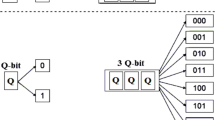Abstract
The ReaxFF interatomic potential, used for organic materials, involves more than 600 adjustable parameters, the best-fit values of which must be determined for different materials. A new method of determining the set of best-fit parameters for specific molecules containing carbon, hydrogen, nitrogen and oxygen is presented, based on a parameter reduction technique followed by genetic algorithm (GA) minimization. This work has two novel features. The first is the use of a parameter reduction technique to determine which subset of parameters plays a significant role for the species of interest; this is necessary to reduce the optimization space to manageable levels. The second is the application of the GA technique to a complex potential (ReaxFF) with a very large number of adjustable parameters, which implies a large parameter space for optimization. In this work, GA has been used to optimize the parameter set to determine best-fit parameters that can reproduce molecular properties to within a given accuracy. As a test problem, the use of the algorithm has been demonstrated for nitromethane and its decomposition products.








Similar content being viewed by others
References
Rapaport DC (1995) The art of molecular dynamics simulation. Cambridge University Press, Cambridge
Tersoff J (1986) Phys Rev Lett 56:632
Brenner DW (1990) Phys Rev B 42:9458
Stuart SJ, Tutein B, Harrison JA (2000) J Chem Phys 112:6472
van Duin A, Dasgupta S, Lorant F, Goddard WA (2001) J Phys Chem A 105:9396
Smeyers YG, Bellido MN (2004) Int J Quant Chem 23:507
Makarov DE, Metiu H (1998) J Chem Phys 108:590
Melandri S, Favero G, Caminati W, Favero B, Esposti AD (1997) J Chem Soc Faraday Trans 93:2131
Graham AP, Hofmann F, Toennies JP, Chen LY, Ying SC (1997) Phys Rev Lett 78:3900
Carlson AF, Madix RJ (2000) Surf Sci 470:62
Kryachko ES, Lwdin O, Brndas E (2004) Fundamental world of quantum chemistry: a tribute to the memory of Per-Olov Lowdin, vol II. Kluwer, Dordrecht
Hutson JM, Ernesti A, Law MM, Roche CF, Wheatley RJ (1996) J Chem Phys 105:9130
Atkins KM, Hutson JM (1996) J Chem Phys 105:440
Prudente FV, Acioli H, Neto JJS (1998) J Phys Chem 109:8801
Saad D, Rattray M (1997) Phys Rev Lett 79:2578
Thompson DL, Wagner AF, Minkoff M (2006) J Phys Conf Ser 46:234
Xu YG, Liu GR (2003) J Micromech Microeng 13:254
Tersoff J (1988) Phys Rev Lett 61:2879
Haskins PJ, Cook M, Fellows J, Wood A (1998) In: Proc 11th Int Symp on Detonation, Aspen, CO, USA, 30 Aug–4 Sept 1998, p 897
Johnston HS, Parr C (1963) J Am Chem Soc 85:2544
Johnston HS (1963) J Am Chem Soc 85:2544
Root DM, Landis CM (1993) J Am Chem Soc 115:4201
Cleveland T, Landis CM (1996) J Am Chem Soc 118:6020
Brenner DW, Shendrova OA, Harrison A, Stuart SJ, Boris N, Sinnott SB (2002) J Phys Condens Matter 14:783
Boris N, Lee KH, Sinnott SB (2004) J Physi Condens Matter 16:7261
Strachan A, van Duin A, Chakraborty D, Dasgupta S, Goddard WA III (2003) Phys Rev Lett 91:098301
Strachen A, Kober EM, van Duin A, Oxaggard J, Goddard WA III (2005) J Chem Phys 122:054502
University of Waterloo Webpage (2011) http://www.science.uwaterloo.ca/~cchieh/cact/c120/bondel.html
DOlgov EY, Batev VA, Godunov IA (2004) Int J Quant Chem 96:193
SoftWare (2011) SoftWare: 64-bit operating system (webpage). http://www.cachesoftware.com/mopac/index.shtml
Croxton FE, Cowden DJ, Klein S (1939) Applied general statistic. Prentice Hall Inc, New York
Holland JH (1975) Adaptation in natural and artificial systems. The University of Michigan Press, Ann Arbor
Deaven DM, Ho KM (1995) Phys Rev Lett 75:288
Acknowledgment
It is a pleasure to acknowledge the help given by Dr. A.C.T. van Duin in providing the Reaxff MD code and also helping with the use of that code.
Author information
Authors and Affiliations
Corresponding author
Rights and permissions
About this article
Cite this article
Pahari, P., Chaturvedi, S. Determination of best-fit potential parameters for a reactive force field using a genetic algorithm. J Mol Model 18, 1049–1061 (2012). https://doi.org/10.1007/s00894-011-1124-2
Received:
Accepted:
Published:
Issue Date:
DOI: https://doi.org/10.1007/s00894-011-1124-2




